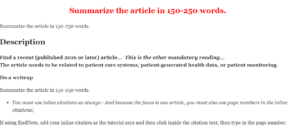Summarize the article in 150-250 words.
Summarize the article in 150-250 words.
Summarize the article in 150-250 words. 
Description
Find a recent (published 2016 or later) article… This is the other mandatory reading...
The article needs to be related to patient care systems, patient-generated health data, or patient monitoring.
Do a writeup
Summarize the article in 150-250 words.
- You must use inline citations as always – And because the focus is one article, you must also use page numbers in the inline citations.
If using EndNote, add your inline citation as the tutorial says and then click inside the citation text, then type in the page number.
- In a further 100-150 words, discuss how your chosen mandatory article compares and contrasts to the Wilson (2017) mandatory reading (attached) – Are the potential benefits and problems of patient monitoring similar, different, or both, and how?
Whe,4 . .,. N,”,,t 1(.1.,fl 1\1\(111 pp.S: � ‘J \� � PATIENT CARE GOES REMOTE IoT devices offer radical new ways to monitor conditions. T o improve the health of pa tients with chronic medical conditions, Ochsner Health System tapped into the In ternet of Things. The health system, based in Jefferson, La., has used IoT, specifically remote mon itoring, to help patients with uncontrolled hypertension lower their blood pressure to healthy levels. Its Hypertension Digital Medicine Program offers participants a By Linda Wilson combination of education on the disease and lifestyle changes, as well as digital de vices to regularly monitor blood pressure and fine-tune medication to optimize dis ease management. To enroll in the hypertension program, which began in 2015, patients need an order from their physician and a smart phone. They then visit one of four O Bars, which are the health system’s stores that sell and provide support for a variety of 20 Health Data Management JULY/AUGUST 2017 health-related apps, wearables and devic es. Patients buy a wireless blood pressure cuff that is designed to work with their smartphone, which can be either an An droid or iOS device. Once at home, they log in to the patient portal, MyChart from Epic, to fill out a questionnaire about their other chronic conditions, social circumstances, medications and lifestyle habits. Patients work with a health coach and pharmacist to develop care regimens that healthdatamanagement.com include both medication and lifestyle goals. Patients measure their blood pres sure between one and five times per week, and the results are transmitted automat ically from the cuff to the EHR via the smartphone. That information is present ed in dashboards for health coaches and pharmacists, enabling better tracking of patient conditions. The program works: More than 70 per cent of the patients enrolled in it get their blood pressure under control within 90 days. Ochsner is one of numerous provid ers currently using apps and connect ed devices. A 2016 survey by IDC of 101 providers and 100 payers exemplifies the ongoing shift. Some 39 percent of provid ers and 52 percent of payers said they are piloting or using loT-the most common uses were for security systems and remote health monitoring. As health systems and integrated de livery networks assume financial risk for their patients’ health outcomes, they’ve begun developing interactive programs that include remote patient monitoring to manage patients’ chronic medical con ditions or transitions from a hospital to home. That certainly has been a driver at Ochs ner, which participates in a variety of re imbursement contracts based, at least in part, on performance, including metrics for the control of blood pressure and blood glucose levels. “We have to think about new models of care delivery if we are going to have both an intermediate- and long-term impact on patients with chronic disease,” says Rich ard Milani, MD, chief clinical transforma tion officer at Ochsner Health System. According to an online survey con ducted in 2016 by Accenture, 76 percent of providers and 77 percent of payers used remote patient monitoring for heart condi tions, including congestive heart failure. Respiratory conditions, including chronic obstructive pulmonary disease (COPD) and asthma, scored high, too, as 61 per- “We have to think about new models of care delivery.” -Richard Milani cent of providers and 49 percent of payers said they developed remote patient mon itoring projects for those diseases. Other chronic conditions in which survey par ticipants use remote patient monitoring include cancer, mental health, diabetes, obesity and orthopedic care. Remote monitoring works better than office visits alone in controlling chronic diseases because of the increased frequen cy with which providers receive-and can react to-biologic data from patients, Mi lani believes. “How can we possibly catch things before they get out of hand if we are seeing you two or three times a year?” he says. John Cassar, CEO of SuperCare Health, a Downey, Calif.-based provider of home care for patients with respiratory diseas es, agrees with Milani’s assessment of the need for new delivery models to engage patients in managing their health. For example, SuperCare designed a “high-tech, high-touch” home-care ser vice for high-risk COPD patients return ing home after a hospital stay. That 30-day program includes an initial visit by a re spiratory therapist, who performs a clini cal assessment and teaches patients how to take medications, such as short- and long-acting inhalers, and use diagnostic tools, such as peak flow meters and pulse oximeters. The therapists also give patients an iPad and show them how to use an iBreathe app, which connects patients to an electronic portal on SuperCare Health’s homegrown care management system. Using the app, patients also enter data about medica tions and readings from peak flow meters, watch educational videos, complete cus tom surveys and participate in telehealth visits with SuperCare Health’s providers. The app, which also is integrated with Bluetooth-enabled pulse oximeters, trans mits information about blood oxygen lev els directly into SuperCare Health’s care management software. The iBreathe app is a customized ver sion of COPD Navigator, an Apple Health Kit-compliant app developed by LifeMap Solutions, San Jose, Calif. SuperCare Health conducted an 18-month trial of the 30-day COPD pro gram, beginning in late 2015. A total of 100 patients were enrolled in the new inter vention, and 100 were assigned to a control group. SuperCare estimates that it saved $1.6 million on avoided hospital readmission costs for patients in the 30-day program. Those patients also logged a COPD read mission rate of 2.94 percent, compared with a national average of 17.1, while their all-cause readmission rate was 7.35 per cent, compared with a national average of 21.2 percent. Other approaches Sharp Rees-Stealy Medical Group, San Diego, uses a variety of devices to mon itor and educate patients with chronic conditions. Of the 240,000 patients at Sharp’s 22 outpatient locations, about 6,000 are as signed to case managers, and 1,000 of those use IoT devices and apps. “We try to use technology in many different forms to meet the needs of our patients and our programs,” says Janet Appel, director ofin formatics and population health at Sharp Rees-Stealy. For example, Sharp uses Medtronic’s wireless blood pressure cuffs to keep tabs on patients with hypertension, and the vendor’s wireless scales for patients with JULY/AUGUST 2017 Health Data Management 21 IOT congestive heart failure (CHF) and chron ic kidney disease. Nurses monitor data and receive automated alerts, contacting physicians when necessary for changes in medications. Sharp’s patients with CHF who are en rolled in the program have 50 percent few er hospital admissions than CHF patients not in the program, according to Appel. Similarly, patients with hypertension typically get their blood pressure under control within 30 days of enrolling in the remote monitoring program, she adds. Sharp also has logged positive results from text messaging programs that it pur chased from Agile Health, Nashville. For example, patients discharged from the hospital who opt to participate in a 90day coaching program, called Welcome Home, are less likely to be readmitted than those who don’t sign up for it, Appel says. Sharp deploys other IoT devices to help patients learn about their disease and how to manage it. The medical group uses a program from Propeller Health, based in Madison, Wis., to teach patients about asthma. After patients download the Propeller Health app, they receive a Bluetooth-en abled sensor in the mail, which they at tach to their rescue inhaler. Information about the time and place they use their inhaler is transmitted to the user’s smart phone app. Patients can then tap into their usage information to gain insights about when and where they use their inhaler, which helps them learn about what trig gers their asthma attacks and, thus, how to prevent them. “It’s kind of a wake-up call for the pa tients because they may not think they are using their inhaler that much,” Appel says of the approximately 50 patients who are enrolled in the program at any given time. While patients learn more about their disease by participating in the asthma program, Appel says Sharp has not no ticed a significant increase in patients’ adherence to medication regimens re- 22 “It’s kind of a wake-up call for the patients.” -Janet Appel quiring daily use of controllers, which dispense long-acting medication to help prevent asthma attacks. Patient engagement and education also are goals for SuperCare Health. That’s why it uses gamification techniques in its iBreathe app. Patients earn points for activities such as watching treatment-re lated videos and taking their medications. Patients currently earn a happy or sad emoji based on the number of points they score, but SuperCare is developing a pro gram that would enable patients to trade points for items with monetary value, such as gift cards, Cassar says. Not all that easy Deploying new care models involving connected devices and apps isn’t without challenges, however. In the IDC survey, both providers and payers said privacy and security issues were among the top barriers to implementing IoT programs. And there’s good reason to worry. Across all industries, nearly half of U.S. based companies using an IoT network have experienced a security breach, ac cording to a 2017 survey released by Al tman Vilandrie & Company, a strategy consulting firm. The problem of protecting networks from the security vulnerabilities posed by devices is magnified after you move out side the walls of an institution, says Jon Connet, senior corporate director of strat egy at ForeScout, a vendor that focuses on tracking onsite devices. For example, it is more difficult to detect and identify offsite devices because traditional techniques, such as public key infrastructures, do not work as well, he says. There are other technical hurdles as well, such as IT infrastructure develop- Health Data Management JULY/AUGUST 2017 ment. For example, Ochsner’s IT team de signed extensive custom programming in the health system’s Epic EHR to create custom surveys, analyze the surveys, as sign patients to risk groups, and present information in dashboards for health coaches and pharmacists, including daily task lists. “You have to be able to organize the work,” Milani says. The system’s IT staff also developed algorithms to predict which patients are headed toward an episode of uncon trolled hypertension based on their re cent blood pressure readings. Currently, there are about 1,400 pa tients in Ochsner’s hypertension pro gram, and Milani says the system hopes to recruit a total of 5,000 patients in the next 12 to 18 months. The typical patient does not leave the program, he adds, be cause many of them experience multiple episodes of uncontrolled blood pressure throughout the course of the disease. In addition to increasing the number of patients involved in hypertension mon itoring, Ochsner also plans to expand into other diseases. The health system’s executives plan to launch remote patient monitoring for diabetes this summer, enrolling from 50 to 100 patients initially and expanding over time. Ochsner also may launch a COPD program this year, Milani says. Ochsner’s IT staff used the experience it gained building the hypertension pro gram as the basis for the diabetes effort, says Milani, adding that the health system had always planned to expand remote pa tient monitoring to multiple chronic dis eases. First, “you have to build the train tracks-the infrastructure, if you will-to do that,” he says. • healthdatamanagement.com
Use the following coupon code :
NursesHomework


